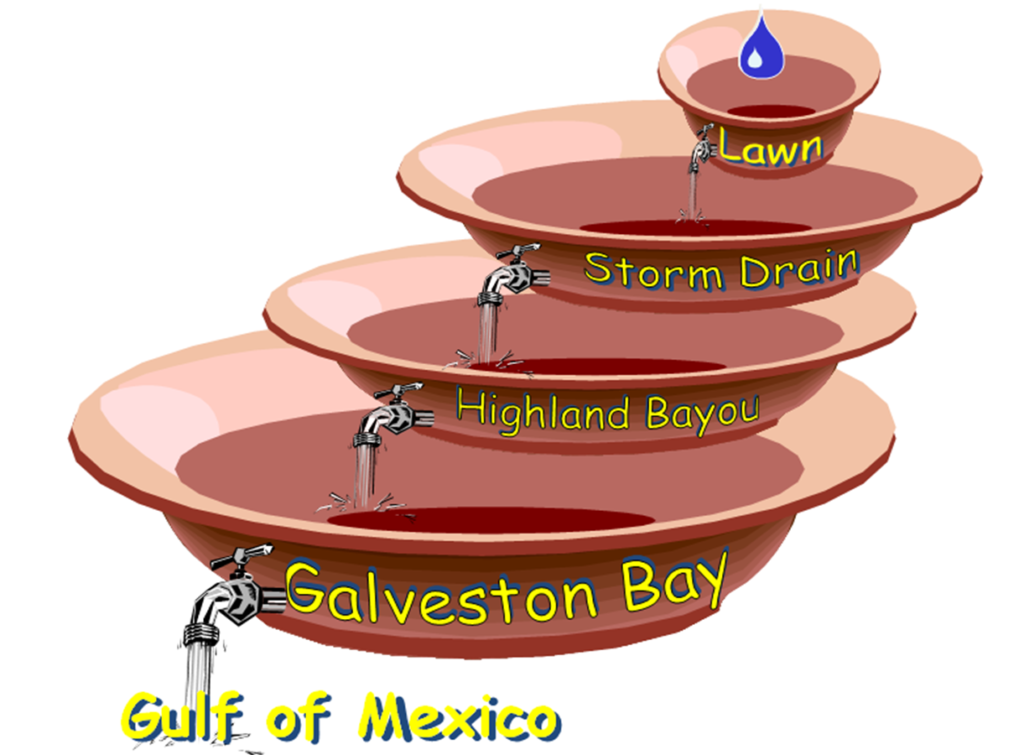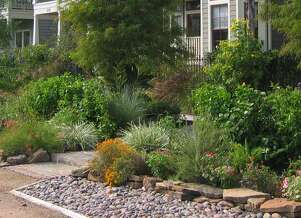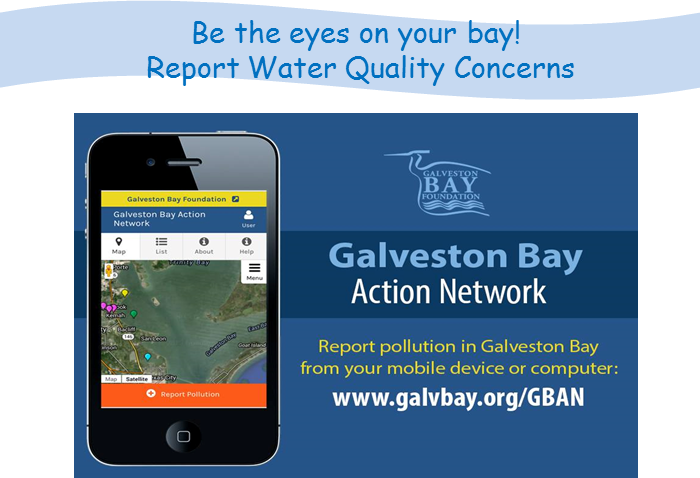When the waterway is not physically next to your property, it can be hard to remember that what you do on your lawn will affect the Bayou. Water from rain, irrigation, and sprinklers flows from your lawns and into storm drains before reaching the bayous. This runoff is NOT treated by sewage plants and it flows untreated into Galveston’s bayous and eventually the Bay. This means that excess fertilizer and pesticides, lawn clippings, pet waste, lawn waste, septic system seepage, and spilled oils and paints flow from your property and into the Bayou.
If you think that your contribution to water pollution is insignificant, remember to add up your runoff to that of your neighbors and the entire community. The result is RUNOFF POLLUTION: the #1 source of water pollution in America’s waterways, more than from sewage and industrial facilities.
WaterSmart landscapes utilize plants and practices that require less water plus little to no fertilizers or pesticides. The best plants are plants that are native to Texas and able to withstand dry and wet spells, along with the long hot summers. WaterSmart landscapes also incorporate water conserving principles into home or commercial landscaping and are estimated to cut about half of the water used for conventional landscaping practices.
Water Harvesting/Rain Barrels:
Water harvesting is the act of capturing, diverting, and storing rainwater for later use. Captured rainwater is often used in landscaping, because the water is free of salts (some wells produce salty water) and other harmful minerals and does not have to be treated. Rain is free and clean. Water harvesting directly benefits you and the community by saving you money on your water bill, reducing demand on the water supply, and reducing run-off, erosion, and contamination of surface water.
Making a rain barrel can be an easy and fun way to harvest water. Follow the steps in this guide and you’ll be well on your way to saving money and water.
A bowl-shaped depression designed as a garden that holds and absorbs stormwater from a roof, sidewalk, parking lot, lawn or street. Rain gardens slow the flow of water, allowing the water to seep downward into the soil, while cleaning the water before it enters the storm drain and empties into our bays and bayous. Many species of Texas plants can be found at plant nurseries that thrive in wet-dry conditions.
To learn how to get started on a rain garden, read this guide offered by AgriLife Extension. To view a recommended list of plants for rain gardens in Texas, visit the Rain Garden Plant List.
Proper Usage of Chemicals and Pesticides:
To prevent harmful effects to your family and the environment, choosing the appropriate pesticide and using it correctly is essential. Another important thing to consider is the storage and proper disposal of chemicals and pesticides.
Remember: Make sure you truly need pesticides before you use it. Most pest issues are a sign of an underlying problem and can usually be solved without chemicals. To read more about managing pests visit EPA’s page.
Composting turns organic matter such as discarded vegetable food, leaves, grass clippings, tree limbs, weeds, and other yard waste into a rich substance called humus. Composting is a better practice then conventional fertilizer because it results in healthier plants, reduces material going to landfills, and saves you money. In the earlier stages of the decomposition process, compost can be used as mulch.
For FAQ, visit the following Home Composting page. For more information visit the following pages:
Composting
Backyard Composting
Composting Food Waste-The Basics
Earth-Kind Landscaping- Don’t Bag it Program
Earth-Kind Landscaping- Composting for Kids
Organic Lawn Care is a combination of practices including, mowing at the right height and grasscycle, using organic fertilizers, composting, using the right amount of water and a good pest management plan.
To learn how you could own an organic lawn, read the following pamphlet.
Native Plants:
- Help conserve water
- Reduce mowing costs
- Provide habitat for birds, butterflies and other wildlife
- Protect the soil and save money on fertilizer and pesticides
- Are hardy and less susceptible to pests and disease
- Unlikely to become invasive
The following are some examples of East Texas native species by Type, please visit Lady Bird Johnson Wildflower Center for the full list.
Trees:
Acer barbatum
Southern sugar maple, Florida maple, Caddo maple
Duration: Perennial
Habit: Tree
Light: Part-shade
Water:Dry
Acer luecoderme
Chalk Maple
Duration: Perennial
Habit: Tree
Light: Part-shade
Water:Dry
Cercis canadensis var. texensis
Texas redbud
Duration: Perennial
Habit: Tree
Light: Sun, Part-shade
Water:Dry
Viburnum rufidulum
Rusty blackhaw viburnum, Rusty blackhaw, Southern blackhaw, Downy viburnum
Duration: Perennial
Habit: Tree
Light: Part-shade
Water:Dry
Shrubs:
Callicarpa americana
American beautyberry, French mulberry
Duration: Perennial
Habit: Shrub
Light: Part-shade
Water:Moist
Rhododendron canescens
Mountain azalea, Wild azalea, Honeysuckle azalea,
Piedmont azalea, Sweet azalea, Hoary azalea, Southern pinxter flower
Duration: Perennial
Habit: Shrub
Light: Part-shade
Water:Dry
Lantana urticoides
Texas lantana, Calico bush, West Indian shrub-verbena
Duration: Perennial
Habit: Shrub
Light: Sun
Water:Dry
Erythrina herbacea
Coralbean, Cherokee bean, Red cardinal
Duration: Perennial
Habit: Shrub
Light: Sun, Part-shade
Water:Dry
Herbs:
Echinacea purpurea
Eastern purple coneflower, Purple coneflower
Duration: Perennial
Habit: Herb
Light: Sun, Part-shade
Water:Dry
Castilleja indivisa
Entireleaf indian paintbrush, Texas paintbrush, Indian paintbrush,
Scarlet paintbrush, Entire-leaf indian-paintbrush
Duration: Annual
Habit: Herb
Light: Sun
Water:Dry
Gaillardia pulchella
Firewheel, Indian Blanket
Duration: Annual
Habit: Herb
Light: Sun, Part-shade
Water:Dry
Ipomopsis rubra
Standing cypress, Texas plume, Red Texas star, Red gilia
Duration: Biennial
Habit: Herb
Light: Sun, Part-shade
Water:Dry
Grass/Grass-like:
Sorghastrum nutans
Indiangrass, Yellow indian grass
Duration: Perennial
Habit: Grass/Grass-like
Light: Sun, Shade, Part-shade
Water:Moist, Dry
Andropogon virginicus
Broomsedge bluestem, Broom-sedge
Duration: Perennial
Habit: Grass/Grass-like
Light: Part-shade
Water:Moist
Bouteloua curtipendula
Sideoats grama
Duration: Perennial
Habit: Grass/Grass-like
Light: Sun, Part-shade
Water:Moist, Dry
Chasmanthium latifolium
Inland sea oats, Indian wood oats, Wild oats, River oats, Flathead oats, Upland Oats
Duration: Perennial
Habit: Grass/Grass-like
Light:Shade, Part-shade
Water:Moist
Do…
select native plants that are well adapted to your region/climate and need little water, fertilizer and pesticides.
Do cover bare areas with trees, shrubs, mulch, and other vegetative cover to help reduce erosion and promote water filtration into the soil.
Do keep lawn clippings on your lawn so they can be reused as fertilizer and put valuable nutrients back into the soil.
Do test your soil before applying fertilizers to prevent over-fertilization and potential leaching and water contamination.
Do compost your yard and garden trimmings. Mixing your compost with your soil means you’ll need less chemical fertilizers.
Do accept a few weeds, like clover, which can coexist nicely with your lawn.
Do group water loving plants together.You can water them as a group and avoid over-watering drought hardy plants.
Don’t…
dispose of grass clippings in waterways-the decomposition process uses up oxygen and will decrease oxygen available for living organism.
Don’t over-treat and over-water your lawn. This can result in insect and fungal problems.
Don’t water during times of day when temperatures are high. Early morning or late afternoon are best.
Don’t water your lawn and beds until they start to wilt.
Don’t cut grass too short. Longer blades above ground mean deeper roots and can absorb more moisture and nutrients. Longer blades can also prevent germination of weeds by creating more shade during weed germination.
[youtube]http://youtu.be/who0nxEL5b4[/youtube]
Things to keep in mind…
- Toxic chemicals such as pesticides and herbicides can harm children, pets, local wildlife and helpful insects.
- Excess fertilizer causes algae blooms, which remove oxygen from the water and results in fish kills.
- Drought conditions make conserving water even more essential.
- Save money on your water bill by using native, drought hardy and adapted plants.
- Water Efficient Practices for Saving Your Landscape
- New updates and resources on drought- AgriLife Extension
- More on Rain Harvesting
- Earth-Kind-AgriLife Extension
- Water Conservation Programs-TCEQ
- Greenacres: Landscaping with Native Plants
- Tips for using Pesticides Properly- AgriLife
- Texas Integrated Pest Management Program
- Integrated Weed Management-AgriLife
- Choosing the Right Pesticide- AgriLife
- National Pesticide Information Center
- Lawn and Garden-Aggie Horticulture
- Mulching and Composting-TCEQ
- AggrieTurf- Turf Answers
- Pesticide Exposure Surveillance in Texas (PEST)- Texas Department of State Health Services
- Managing 10 Common Texas Yard Pests- TCEQ
- Managing Lawn Problems in Texas- TCEQ
- Landscape Irrigation- TCEQ
- Water Use Calculator- H2O Conserve
- US Composting Council
- Irrigation Watering Recommendations- AgriLife




















